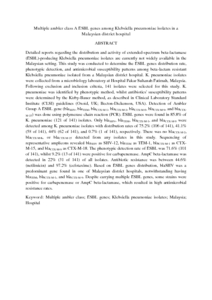Citation
Ujir, Mohd Helmi and Mohd Desa, Mohd Nasir and Mohd Taib, Niazlin and Tengku Jamaluddin, Tengku Zetty Maztura and Masri, Siti Norbaya
(2016)
Multiple ambler class A ESBL genes among Klebsiella pneumoniae isolates in a Malaysian district hospital.
Tropical Biomedicine, 33 (1).
pp. 109-119.
ISSN 0127-5720
Abstract
Detailed reports regarding the distribution and activity of extended-spectrum beta-lactamase (ESBL)-producing Klebsiella pneumoniae isolates are currently not widely available in the Malaysian setting. This study was conducted to determine the ESBL genes distribution rate, phenotypic detection, and antimicrobial susceptibility patterns among beta-lactam resistant Klebsiella pneumoniae isolated from a Malaysian district hospital. K. pneumoniae isolates were collected from a microbiology laboratory at Hospital Pakar Sultanah Fatimah, Malaysia. Following exclusion and inclusion criteria, 141 isolates were selected for this study. K. pneumoniae was identified by phenotypic method, whilst antibiotics' susceptibility patterns were determined by the Kirby-Bauer method, as described in Clinical Laboratory Standard Institute (CLSI) guidelines (Oxoid, UK; Becton-Dickenson, USA). Detection of Ambler Group A ESBL gene (blaSHV, blaTEM, blaCTX-M-1, blaCTX-M-2, blaCTX-M-8, blaCTX-M-9, and blaCTX-M-25) was done using polymerase chain reaction (PCR). ESBL genes were found in 85.8% of K. pneumoniae (121 of 141) isolates. Only blaSHV, blaTEM, blaCTX-M-1, and blaCTX-M-9 were detected among K. pneumoniae isolates with distribution rates of 75.2% (106 of 141), 41.1% (58 of 141), 44% (62 of 141), and 0.7% (1 of 141), respectively. There was no blaCTX-M-2, blaCTX-M-8, or blaCTX-M-25 detected from any isolates in this study. Sequencing of representative amplicons revealed blaSHV as SHV-12, blaTEM as TEM-1, blaCTX-M-1 as CTX-M-15, and blaCTX-M-9 as CTX-M-18. The phenotypic detection rate of ESBL was 71.6% (101 of 141), whilst 9.2% (13 of 141) were positive for carbapenemase. AmpC beta-lactamase was detected in 22% (31 of 141) of all isolates. Antibiotic resistance was between 44.6% (netilmicin) and 97.2% (cefotaxime). Based on ESBL genes distribution, blaSHV was a predominant gene found in one of Malaysian district hospitals, notwithstanding having blaTEM, blaCTX-M-1, and blaCTX-M-9. Despite carrying multiple ESBL genes, some strains were positive for carbapenemase or AmpC beta-lactamase, which resulted in high antimicrobial resistance rates.
Download File
![[img]](http://psasir.upm.edu.my/53350/1.hassmallThumbnailVersion/Multiple%20ambler%20class%20A%20ESBL%20genes%20among%20Klebsiella%20pneumoniae%20isolates%20in%20a%20Malaysian%20district%20hospital.pdf)  Preview |
|
PDF
Multiple ambler class A ESBL genes among Klebsiella pneumoniae isolates in a Malaysian district hospital.pdf
Download (9kB)
| Preview
|
|
Additional Metadata
Actions (login required)
 |
View Item |

